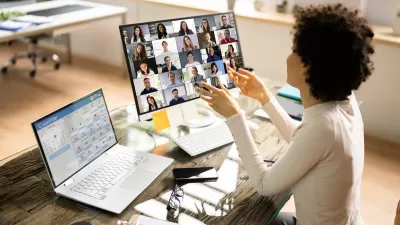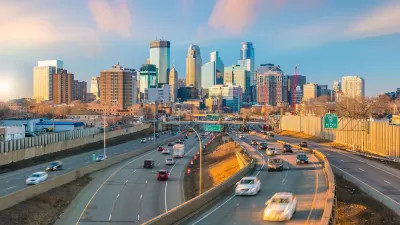The pandemic let many people experience a commute-free lifestyle, but can we reduce rush-hour traffic as we make our return to physical workplaces?

"Every recent survey reports that the rush-hour commute is, to most of the drivers who endure it, the most difficult and unpleasant part of their day," writes Alan Ehrenhalt. "It is also the most alienating." Yet "[i]t shouldn’t be forgotten that the solo commute is a creation of the 20th century. In Victorian times, work and home life were concentrated in the same places." In fact, "[t]he nightmares of rush hour were and are creatures of the automobile, the modern suburb and the zoning ordinances that have rigidly separated commercial and industrial enclaves from the residential districts of metro areas."
During the pandemic, travel patterns shifted significantly. "Drivers, especially those working at home, have been spacing out their travel much more evenly over the course of the day," flattening the rush hour traffic peaks. "Is there a way we can buck the historical trend of eventual return to congestion and keep something like the current arrangement going?"
In lieu of a scenario where a significant percentage of workers keep working from home(a possibility that carries its own rippling implications), Ehrenhalt argues that a simple solution to the commute problem "would be to bring most remote workers back to the center city but to stagger their hours, as has been happening to a limited extent already." Our "nightmare rush hours" are a result of "inefficient management practices — we could wake up from the nightmare with a commitment to sensible scheduling."
Of course, writes Ehrenhalt, "the most appealing long-term answer is for more of us to live near the places where we work," reducing the need for extensive travel to and from work. The commuting problem can only be solved by eliminating the need for it for more people.
FULL STORY: Is There an Exit Ramp from the Rush-Hour Nightmare?

Alabama: Trump Terminates Settlements for Black Communities Harmed By Raw Sewage
Trump deemed the landmark civil rights agreement “illegal DEI and environmental justice policy.”

Planetizen Federal Action Tracker
A weekly monitor of how Trump’s orders and actions are impacting planners and planning in America.

The 120 Year Old Tiny Home Villages That Sheltered San Francisco’s Earthquake Refugees
More than a century ago, San Francisco mobilized to house thousands of residents displaced by the 1906 earthquake. Could their strategy offer a model for the present?

In Both Crashes and Crime, Public Transportation is Far Safer than Driving
Contrary to popular assumptions, public transportation has far lower crash and crime rates than automobile travel. For safer communities, improve and encourage transit travel.

Report: Zoning Reforms Should Complement Nashville’s Ambitious Transit Plan
Without reform, restrictive zoning codes will limit the impact of the city’s planned transit expansion and could exclude some of the residents who depend on transit the most.

Judge Orders Release of Frozen IRA, IIJA Funding
The decision is a victory for environmental groups who charged that freezing funds for critical infrastructure and disaster response programs caused “real and irreparable harm” to communities.
Urban Design for Planners 1: Software Tools
This six-course series explores essential urban design concepts using open source software and equips planners with the tools they need to participate fully in the urban design process.
Planning for Universal Design
Learn the tools for implementing Universal Design in planning regulations.
Clanton & Associates, Inc.
Jessamine County Fiscal Court
Institute for Housing and Urban Development Studies (IHS)
City of Grandview
Harvard GSD Executive Education
Toledo-Lucas County Plan Commissions
Salt Lake City
NYU Wagner Graduate School of Public Service





























